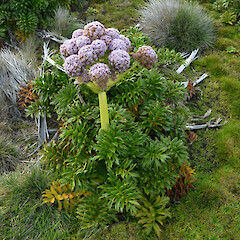Anisotome latifolia
Synonyms
Ligusticum latifolium (Hook.f.) Hook.f., Calosciadium latifolium (Hook.f.) Endl. ex Walp., Aciphylla latifolia (Hook.f.) Cockayne
Family
Apiaceae
Flora category
Vascular – Native
Endemic taxon
Yes
Endemic genus
No
Endemic family
No
Structural class
Herbs - Dicotyledons other than Composites
NVS code
The National Vegetation Survey (NVS) Databank is a physical archive and electronic databank containing records of over 94,000 vegetation survey plots - including data from over 19,000 permanent plots. NVS maintains a standard set of species code abbreviations that correspond to standard scientific plant names from the Ngä Tipu o Aotearoa - New Zealand Plants database.
ANILAT
Current conservation status
The conservation status of all known New Zealand vascular plant taxa at the rank of species and below were reassessed in 2017 using the New Zealand Threat Classification System (NZTCS) – more information about this can be found on the NZTCS website. This report includes a statistical summary and brief notes on changes since 2012 and replaces all previous NZTCS lists for vascular plants.
Please note, threat classifications are often suggested by authors when publications fall between NZTCS assessment periods – an interim threat classification status has not been assessed by the NZTCS panel.
- Conservation status of New Zealand indigenous vascular plants, 2017 . 2018. Peter J. de Lange, Jeremy R. Rolfe, John W. Barkla, Shannel P. Courtney, Paul D. Champion, Leon R. Perrie, Sarah M. Beadel, Kerry A. Ford, Ilse Breitwieser, Ines Schönberger, Rowan Hindmarsh-Walls, Peter B. Heenan and Kate Ladley. Department of Conservation. Source: NZTCS and licensed by DOC for reuse under the Creative Commons Attribution 4.0 International licence.
2017 | At Risk – Naturally Uncommon | Qualifiers: CD, RR
Previous conservation statuses
2012 | At Risk – Naturally Uncommon | Qualifiers: CD
2009 | At Risk – Naturally Uncommon
2004 | Range Restricted
Distribution
Endemic. Auckland Islands and Campbell Island/Motu Ihupuku.
Habitat
Coastal to montane on peaty ground amongst boulders, tussocks and other megaherbs, more rarely under scrub and low forest. Most abundant at lower alitudes.
Detailed description
Robust perennial herb reaching up to 2 m tall. Basal leaves firmly coriaceous, ovate 0.3–0.6 × 0.1–0.2 dm; 2-pinnate, leaflets in 5–7 pairs, dark green to yellow-green, ovate to lanceolate, shortly petiolulate or sessile;leaflet margins cartilaginous, pinnatifid or deeply incised into broad toothed or incised segments; teeth acute, piliferous with hairs 2.0–3.5 mm long; petioles 0.15–0.3m × 7.0–15.0 mm, subterete, with a central ridge on the somewhat flattened adaxial surface; sheaths 50–80 × 35–50 mm, prolonged at the apex into two broad lobes free from the petioles by 2–3 mm; cauline leaf sheaths markedly inflated; peduncles 20–150 mm long. Inflorescence axis up to 2 m × 10–15 mm diameter at first node. Flowers off white to pale creamy pink. Staminate flowers held within an involucre of linear to lanceolate bracts 5–15 × 1–2 mm; involucel of several linear to lanceolate bracteoles 3.0–7.0 × 0.5–1.5 mm; rays 20–40, 5–20 mm long; pedicels 20–40, 2–5 mm long. Pistillate flowers similar, involucre bracts linear to broadly lanceolate, 10–35 × 1–5 mm, involucel bracteoles linear to lanceolate 2.0–10.0 × 0.5–2.0 mm, rays 20–40, 10–35 mm long, pedicels 15–30, 1–5 mm long; styles slender, 1–2 mm long, divergent. Mericarp elliptic, elliptic-ovate, elliptic-oblong or narrowly elliptic, 3.5–5.5–7.0 mm long; apex usually slightly narrowed and obtuse, sometimes rounded, base obtuse to truncate; 2–5-ribbed; ribs usually even, sometimes irregular, equal thin, finely winged with a narrow hyaline margin; surface dull; ribs yellow, dark yellow or orange; vittae usually obscured in mature mericarps, if visible dark red-brown.
Similar taxa
Probably allied to Anisotome acutifolia Kirk, A. antipoda Hook.f. and A. lyallii Hook.f., four species that can grow as tall as 2 m when flowering and are confined to the southern South Island and Stewart Island/Rakiura (A. lyallii) or the Subantarctic Islands (A. acutifolia, A. antipoda and A. latifolia). Anisotome latifolia is sympatric on the Auckland Islands and Campbell Island/Motu Ihupuku with A. antipoda from which it can be easily distinguished by its muich more coarsely divided leaves, and off white to pale pink rather than dark pink to magenta flowers.
Flowering
October–February
Flower colours
Cream, White
Fruiting
January–March
Life cycle
Winged mericarps are dispersed by wind (Thorsen et al., 2009).
Propagation technique
Easy from fresh seed. Easily grown in a deep, peaty, permanently damp soil. Resent hot, humid weather and prone to collapse under such conditions. A beautiful plant that deserves to be more widely cultivated than it currently is.
Threats
No apparent threats. Listed because it is naturally confined to a small geographic area. It is abundant on Campbell Island/Motu Ihupuku and common on those islands of the Auckland group free of browsing animals.
Etymology
anisotome: Unequal sided
Attribution
Fact Sheet prepared for NZPCN by P.J. de Lange 14 April 2007. Description based on Dawson (1961).
References and further reading
Dawson JW. 1961. A revision of the genus Anisotome (Umbelliferae). University of California Publications in Botany 33: 1–98.
Thorsen MJ, Dickinson KJM, Seddon PJ. 2009. Seed dispersal systems in the New Zealand flora. Perspectives in Plant Ecology, Evolution and Systematics 11: 285–309. https://doi.org/10.1016/j.ppees.2009.06.001.
NZPCN Fact Sheet citation
Please cite as: de Lange, P.J. (Year at time of access): Anisotome latifolia Fact Sheet (content continuously updated). New Zealand Plant Conservation Network. https://www.nzpcn.org.nz/flora/species/anisotome-latifolia/ (Date website was queried)






























